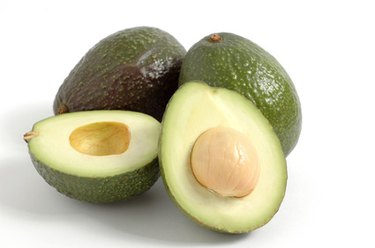
Triglycerides are a type of lipid, or fat, found in your blood. When you eat, your body converts calories it does not use right away into triglycerides, which your body later stores in your fat cells. Between meals, hormones release triglycerides to provide you with energy. Regularly eating more calories than you burn may lead to high triglyceride levels in your blood. There are three different types of triglycerides.
Basics
Video of the Day
A triglyceride comprises three fatty acids attached to glycerol. The three types of fatty acids that compose triglycerides are saturated, monounsaturated and polyunsaturated fatty acids. From these three types of fatty acids come the three types of triglycerides, or fats; saturated, monounsaturated and polyunsaturated triglycerides.
Video of the Day
Saturated Triglycerides
In saturated triglycerides, or saturated fats, most of the fatty acids are saturated, which technically means that each carbon atom has the maximum number of attached hydrogen atoms. Saturated fats are the biggest dietary cause of high LDL, or 'bad', cholesterol levels. You should avoid foods that list a high percentage of saturated fat on the label; saturated fats should represent at most only 10% of your total calorie intake. Saturated fats are found in many animal products such as butter, cheese, whole milk, ice cream, cream and fatty meats.
Monounsaturated Triglycerides
Most of the fatty acids are monounsaturated in monounsaturated triglycerides; one pair of hydrogen atoms in the middle of the molecule is missing. Monounsaturated fats are a type of unsaturated fat. Eating unsaturated fats instead of saturated fats can help lower your blood cholesterol. Foods with high levels of monounsaturated fats include vegetable oils such as olive oil, canola oil, peanut oil and sesame oil. You can also get monounsaturated fats by eating avocados, peanut butter and a variety of nuts and seeds.
Polyunsaturated Triglycerides
Most of the fatty acids are polyunsaturated in polyunsaturated fats. Polyunsaturated fatty acids are two or more pairs of hydrogen atoms short of saturation; two examples are omega-3 and omega-6 fatty acids. Polyunsaturated fat is another type of unsaturated fat, and they too can help lower your cholesterol levels when you consume them instead of saturated fats. Foods that contain polyunsaturated fats include many vegetables oils and fatty fish such as salmon, mackerel, herring and trout.
Trans Fats
You may be wondering where hydrogenated trans fats fit into the picture. These trans fats are not naturally occurring; an industrial process adds hydrogen to liquid vegetable oils, making them solid at room temperature. The American Heart Association reports that trans fats raise your bad LDL cholesterol while lowering your good HDL levels, and they also increase your risk of developing heart disease, stroke and type 2 diabetes. Trans fatty acids are found in fried foods and commercial baked goods such as cookies, donuts and crackers, as well as in processed foods and many margarines.
- MayoClinic.com: High Cholesterol, Triglycerides: Why Do They Matter?; June 17, 2010
- "Nutrition for Foodservice and Culinary Professionals": Karen E Drummond and Lisa M Brefere, CEC, AAC; 2010
- MedlinePlus: Fat; Neil K. Kaneshiro, MD, MHA; August 2, 2009
- American Heart Association: Monounsaturated Fats; October 29, 2010
- American Heart Association: Polyunsaturated Fats; October 29, 2010
- American Heart Association: Trans Fats; October 29, 2010
Is this an emergency? If you are experiencing serious medical symptoms, please see the National Library of Medicine’s list of signs you need emergency medical attention or call 911.